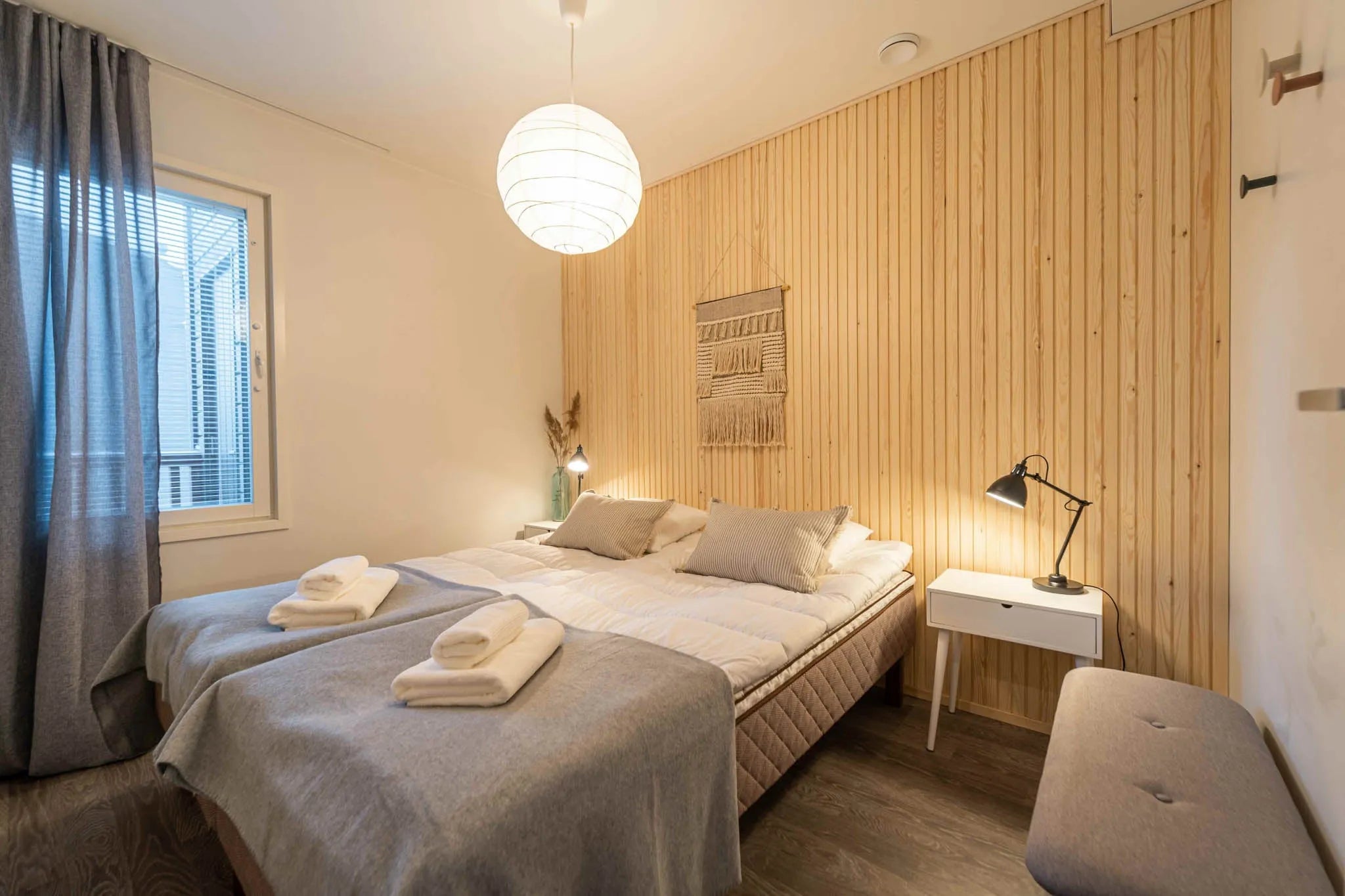Explore the different profiles of interior panels and find the perfect choice for your home
The panel profile – that is, its shape and width – significantly affects the overall look of the paneled surface. Different profiles can create very different results, from traditional to modern playful looks! In this blog post, we introduce and compare five popular panel profiles – slat panel, dune panel, finger joint panel, beadboard panel, and carcass panel – and we provide inspiration and practical tips on how you can utilize these wonderful solutions in your own interior design.
Slat panel – a friend of modern minimalism
Slat panel is definitely one of the trendiest options. Its narrow and angular slats create a clean-lined and modern look in the space, which suits especially Scandinavian, clean-lined interior styles.
The panel works especially well as a ceiling panel, creating a slatted ceiling effect in the space. The panel is significantly more pleasant and faster to install compared to individual slats, which is why it is the choice of many who dream of a slatted ceiling. Slat panel is also at its best as small accent walls, such as in cabinet recesses, WC end walls, and islands.
Slat paneling is available in many different treatments and materials, and the shape and sizes of the slats may vary. A classic choice is the STS profile, where the slats are sharp. If you want a bit more softness in the space, choose the STP-profiled panel. Fans of narrower slats will like the RIMA-3 panel, which is a heat-treated pine panel especially suitable for humid spaces.



Dune panel – a calm and sensory choice

Dune panel evokes the soft shapes of sand dunes and the tranquility of nature. This panel is especially beautiful on large wall surfaces where its wavy form can shine. The Dune panel creates a soft and harmonious atmosphere in the space, making it a perfect choice for, for example, a bedroom or a spa-like bathroom.
The Dune panel pairs well with natural materials and tones, and its texture adds interest and depth to the interior. The Dune panel is available unfinished, white lacquered, and thermally treated. By choosing the Dune panel, you get both a visual and peaceful look for the space.

With the Dune panel, you can create a calming and modern look, for example, in the bedroom.

Thermally treated Dune panel is especially suitable for a spa atmosphere.
Finger panel – playful yet timeless

Finger panel is a traditional and timeless choice. This panel, familiar from post-war houses, brings a playful and dynamic look to the space. The panel's surface pattern consists of regularly repeating "fingers" that create a rhythmic and lively surface.
Paneling was popular in 1940s–1950s detached houses but has made a strong comeback in modern homes as well. Nowadays, finger-jointed paneling is especially popular on bedroom feature walls and headboards, and it is used as accent walls in living rooms, guest rooms, children's rooms, and offices.
The timeless finger-jointed panel works great on both small and large surfaces. Finger-jointed paneling can act as an eye-catcher in details or create a unified look for the entire room. Get inspired by these uses of finger-jointed paneling.
With finger-jointed panels, you can play with different color options and wood species. The popular profile is available unfinished, white lacquered, heat-treated, and sauna-protected.

Finger-jointed paneling also suits a cottage atmosphere.

Finger-jointed paneling is a familiar sight, for example, as a headboard.

Finger-jointed paneling also works well in details, such as cabinet doors.
Bead paneling – romantic and traditional

Beadboard panel is a traditional choice that brings a touch of rustic romance to the space. This classic panel model is especially familiar as a ceiling panel and half-paneling. Beadboard panel is particularly suitable for rustic romantic settings or old wooden houses where you want to preserve the building's unique atmosphere. Beadboard panel is available either unfinished or white.

Bead paneling is at its best, for example, as ceiling paneling in traditional wooden house interiors.
Tongue-and-groove paneling – the soft-lined sibling of slat paneling

Tongue-and-groove paneling is very similar to slat paneling. The tongue-and-groove panel's slat is slightly convex and wavy, creating a softer overall effect. Therefore, tongue-and-groove paneling is also suitable for more traditional and rustic romantic settings, but like slat paneling, it is an excellent choice for modern spaces as well.

The lower part of this bench is upholstered with unfinished tongue-and-groove paneling.

Our Habitare booth island was upholstered with tongue-and-groove paneling. From a distance, the overall look resembles a slat panel.

Up close, you can see how beautiful the wavy surface of the tongue-and-groove panel is.
PANELING CHECKLIST:
- Not all panels may be suitable for all spaces, so choose the right panel specifically for the space.
- Treat wood-finished panels before installation.
- Consider the installation direction carefully in advance.
- Calculate the required amount carefully, use the consumption calculator to assist you.
- Allow the panels to acclimate to the installation environment for about 5-6 days before installation.
- Install large surfaces from the same production batch.
- Panels should be installed on top of battens.
- If the female groove's lower lip of the panel is longer, the panel can be blind-nailed.
- Finish with suitable floor, cover, or ceiling moldings.
- Lights or other heavy objects must not be attached directly to the panel.
Read our comprehensive paneling instructions here!



